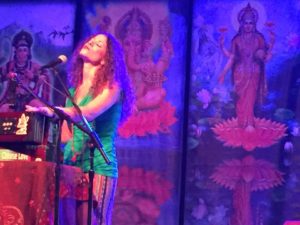Know Thyself: Heed the Call of Kirtan
By Nancy B. Loughlin
Published in News Press on April 5, 2016
You can always try to figure things out. Or, you could just drop in, fall into grace and stop analyzing to death.
These are the words of Missy Balsam, Naples yoga teacher and Kirtan artist who recently appeared at Ruby and Pearl’s Yoga Studio, Fort Myers.
Kirtan is a style of call-and-response chanting and an element of Bhakti yoga, the yoga of devotion. Kirtan, according to Balsam, is a method for falling into that grace, the object of so many seekers’ quests.
In other words, Kirtan’s chanting and singing can help you shed your preoccupation with self and ego and usher you into a state of spiritual oneness with all that is.
How?
“The repetition of the chant and the vibrations of the mantras permeate our beings, and we become infused with feelings such as joy, bliss and peace, which the yogis say is our natural state,” Balsam explained.
It’s also about combatting “monkey mind.”
Balsam explained we are all victims of “mass conditioning,” the conditioning that plasters “sticky notes” over our minds that declare our worth comes from doing and accomplishing while being is never enough.
“We need to prove our worth. I know I always felt like this throughout my life, and I am still battling the dismantling of that conditioning. We can’t look to others for approval and validation. We need to give it to ourselves, to feel we are whole and complete already,” Balsam said.
When Balsam steps to the stage to lead audiences in Kirtan chants, she doesn’t call it a performance; it is a “co-formance.” The Kirtan leader may lead the call and the audience may respond, but all are one.
“We feel that oneness in the energetic circuit of the call and response, giving and receiving. We are practicing together,” she said.
Most of the Kirtan chants are commonly in Sanskrit and focus on Hindu deities: Ganesha (the remover of obstacles); Shiva (the destroyer); Hanuman (the monkey god of selflessness); Krishna (an incarnation of Vishnu and a god of love); Lakshmi (goddess of wealth and prosperity); Saraswati (goddess of knowledge and creativity); Kali (a liberator and destroyer of ego); Durga (the mother of the universe) and Ram and Sita (husband and wife, righteous and loyal).
Does this make Kirtan religion?
Not really. From the yogic perspective, the divine is within you and is all things; there is nothing not divine.
These Hindu deities chanted in the Kirtan represent the mosaic of all facets of self. If you are trying to access the energy of change and transformation, chant to Shiva. If you are exploring abundance in life, both spiritual and material, chant to Lakshmi. If you seek creative, artistic expression, chant to Saraswati.
Shift from the concept of them being different deities to a recognition that they are different manifestations of one divine energy, just like every one of us,” Balsam said.
And after you chant, bask in its vibratory effect.
You’ll be in the “bhav,” as they say in Kirtan, and dropped into grace.
If you want to chant with Missy Balsam, visit her schedule on her website: www.MissyBalsamYoga.com.


